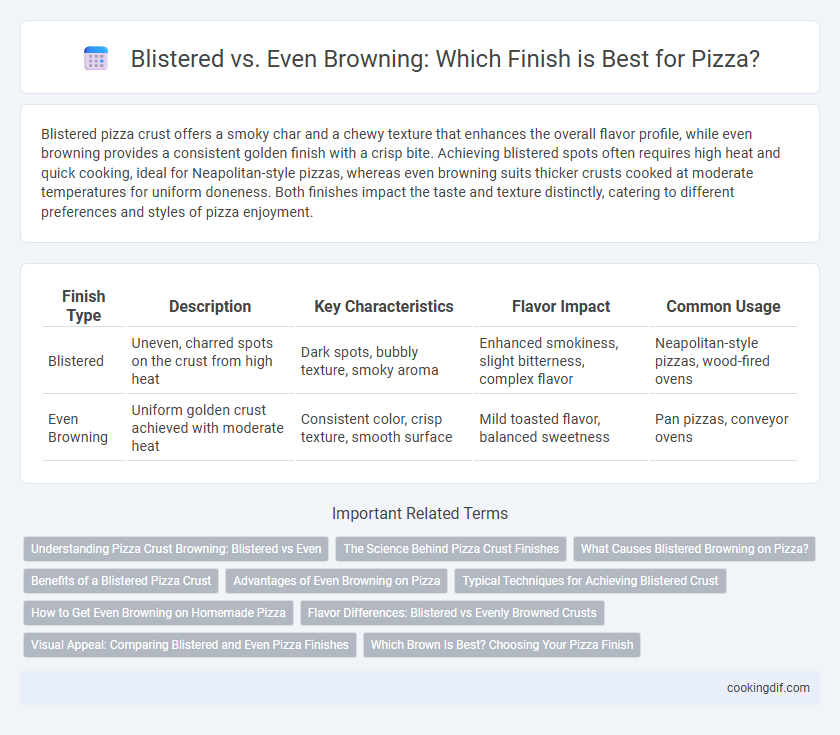Blistered pizza crust offers a smoky char and a chewy texture that enhances the overall flavor profile, while even browning provides a consistent golden finish with a crisp bite. Achieving blistered spots often requires high heat and quick cooking, ideal for Neapolitan-style pizzas, whereas even browning suits thicker crusts cooked at moderate temperatures for uniform doneness. Both finishes impact the taste and texture distinctly, catering to different preferences and styles of pizza enjoyment.
Table of Comparison
| Finish Type | Description | Key Characteristics | Flavor Impact | Common Usage |
|---|---|---|---|---|
| Blistered | Uneven, charred spots on the crust from high heat | Dark spots, bubbly texture, smoky aroma | Enhanced smokiness, slight bitterness, complex flavor | Neapolitan-style pizzas, wood-fired ovens |
| Even Browning | Uniform golden crust achieved with moderate heat | Consistent color, crisp texture, smooth surface | Mild toasted flavor, balanced sweetness | Pan pizzas, conveyor ovens |
Understanding Pizza Crust Browning: Blistered vs Even
Blistered pizza crust features distinct, charred bubbles that enhance smoky flavor and texture, typical of high-temperature cooking in wood-fired ovens. Even browning provides a uniform golden color, indicating controlled heat exposure and yielding a crisp, evenly cooked crust. Understanding these differences helps in selecting the ideal crust finish based on desired taste and baking method.
The Science Behind Pizza Crust Finishes
Blistered pizza crust results from intense, localized heat causing rapid water vaporization and Maillard reactions, creating small charred bubbles that enhance flavor complexity. Even browning occurs when heat distribution is uniform, allowing proteins and sugars to caramelize evenly, producing a consistent golden crust. The science behind these finishes involves controlling oven temperature and cooking time to balance moisture evaporation and sugar-protein interactions for the desired crust texture and taste.
What Causes Blistered Browning on Pizza?
Blistered browning on pizza results from intense, uneven heat exposure, typically in wood-fired ovens reaching temperatures above 800degF, which causes rapid charring and small, dark bubbles on the crust. This effect is largely due to the Maillard reaction and caramelization occurring faster in localized hot spots, creating distinctive charred bubbles that enhance texture and flavor. In contrast, even browning occurs in lower-temperature ovens with steady heat distribution, producing a uniform golden crust without the characteristic blisters.
Benefits of a Blistered Pizza Crust
A blistered pizza crust offers a distinct smoky flavor and a satisfying crunch that enhances the overall eating experience. The uneven browning creates pockets of char that trap heat, resulting in a perfectly airy and light interior. This technique also improves texture contrast, making each bite more dynamic compared to an evenly browned crust.
Advantages of Even Browning on Pizza
Even browning on pizza ensures consistent heat distribution, resulting in a uniform crust texture that is crispy without being burnt. This method enhances flavor profiles by maintaining a balanced Maillard reaction across the surface, preventing bitter spots often found with blistered spots. Additionally, even browning provides an aesthetically appealing golden finish, making the pizza more visually inviting and consistently delicious.
Typical Techniques for Achieving Blistered Crust
Achieving a blistered crust on pizza typically involves cooking at extremely high temperatures, often between 800degF to 900degF, which promotes rapid charring and bubbly surface textures. Using a wood-fired oven or a pizza stone preheated for at least an hour ensures intense, direct heat that creates the signature blisters and rose-colored spots. Hydration levels in the dough, usually around 65-70%, also play a crucial role by producing steam during baking, further enhancing the blistered effect over even browning.
How to Get Even Browning on Homemade Pizza
Achieving even browning on homemade pizza requires consistent oven temperature and proper placement on a preheated pizza stone or steel, which promotes uniform heat distribution. Using a thin, well-stretched dough with minimal toppings prevents uneven cooking and blistering in hot spots. Rotating the pizza halfway through baking ensures balanced exposure to heat, resulting in a perfectly browned crust with a consistent finish.
Flavor Differences: Blistered vs Evenly Browned Crusts
Blistered crusts develop intense, smoky flavors due to high heat caramelizing the dough's sugars in localized spots, creating a complex, slightly charred taste. Evenly browned crusts result in a uniform, toasty flavor with a balanced crunch but lack the dynamic flavor variations found in blistered crusts. Choosing between blistered and evenly browned finishes directly impacts the pizza's flavor profile, where blistering offers bold character and even browning provides a consistent, mild taste.
Visual Appeal: Comparing Blistered and Even Pizza Finishes
Blistered pizza crusts showcase a charred, leopard-spotted appearance that signals high-heat cooking, enhancing visual appeal through texture contrast and artisanal authenticity. Even browning delivers a uniform golden hue, suggesting controlled, consistent heat application, and appealing to those who prefer a classic, balanced finish. Both finishes influence customer perception, with blistered crusts often perceived as more rustic and flavorful, while even browning conveys precision and traditional baking technique.
Which Brown Is Best? Choosing Your Pizza Finish
Blistered browning on pizza crust provides a smoky, charred flavor and a crisp texture that highlights the artisanal qualities of Neapolitan-style pizzas. Even browning offers a uniform, golden finish ideal for consistent crunch and a visually appealing, classic look often preferred in New York-style and thin-crust pizzas. Selecting the best brown finish depends on desired texture and flavor intensity, with blistered emphasizing charred complexity and even browning delivering balanced crispness.
Blistered vs even browning for finish Infographic

 cookingdif.com
cookingdif.com